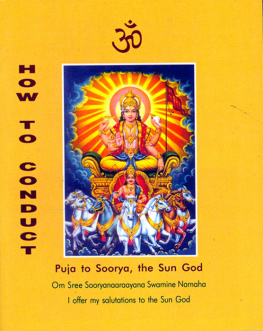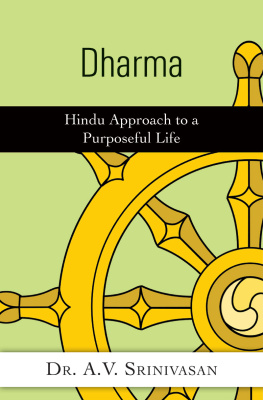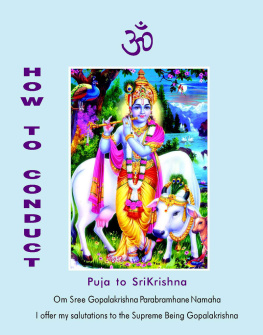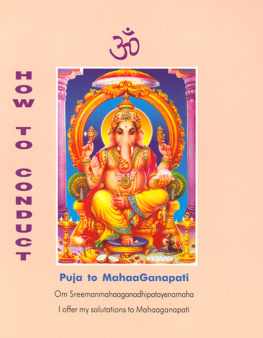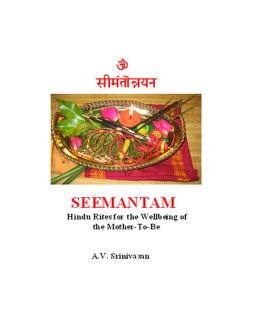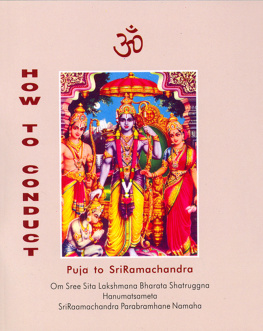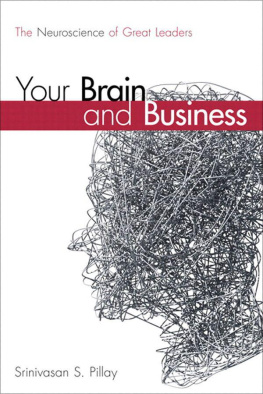Dr. A. V. Srinivasan - How to Conduct Puja to Soorya
Here you can read online Dr. A. V. Srinivasan - How to Conduct Puja to Soorya full text of the book (entire story) in english for free. Download pdf and epub, get meaning, cover and reviews about this ebook. year: 2012, publisher: Dr. A. V. Srinivasan, genre: Home and family. Description of the work, (preface) as well as reviews are available. Best literature library LitArk.com created for fans of good reading and offers a wide selection of genres:
Romance novel
Science fiction
Adventure
Detective
Science
History
Home and family
Prose
Art
Politics
Computer
Non-fiction
Religion
Business
Children
Humor
Choose a favorite category and find really read worthwhile books. Enjoy immersion in the world of imagination, feel the emotions of the characters or learn something new for yourself, make an fascinating discovery.
- Book:How to Conduct Puja to Soorya
- Author:
- Publisher:Dr. A. V. Srinivasan
- Genre:
- Year:2012
- Rating:3 / 5
- Favourites:Add to favourites
- Your mark:
- 60
- 1
- 2
- 3
- 4
- 5
How to Conduct Puja to Soorya: summary, description and annotation
We offer to read an annotation, description, summary or preface (depends on what the author of the book "How to Conduct Puja to Soorya" wrote himself). If you haven't found the necessary information about the book — write in the comments, we will try to find it.
How to Conduct Puja to Soorya — read online for free the complete book (whole text) full work
Below is the text of the book, divided by pages. System saving the place of the last page read, allows you to conveniently read the book "How to Conduct Puja to Soorya" online for free, without having to search again every time where you left off. Put a bookmark, and you can go to the page where you finished reading at any time.
Font size:
Interval:
Bookmark:
How to Conduct
Puja to Soorya
by
Dr. A. V. Srinivasan

Foreword by Sri. Swami Satchidananda
A Parijata Publication
2013

Puja Booklet Series
How to conduct puja
in the privacy of your own home in America
and in the company of your family and friends
How to Conduct Puja to Soorya
How to Conduct Puja to Shiva
How to Conduct Puja to SriRamachandra
How to Conduct Puja to SriKrishna
How to Conduct Puja to MahaaGanapati
How to Conduct Puja to Goddess Saraswati
How to Conduct Puja to Durgadevi
How to Conduct Puja to Mahalakshmi
How to Conduct Puja to the Navagrahas
Available in print from Amazon.com and Abebooks.com and as ebooks wherever ebooks are sold.
How to Conduct
Puja to Soorya
in the privacy of your own home
and in the company of your family and friends
by
Dr. A. V. Srinivasan
with transliterations from Sanskrit and English translations
Revised Edition 2013
A. V. Srinivasan 1999, 2013
ISBN: 978-1-62209-577-3
No part of this ebok may be reproduced in any form without prior written permission from the publisher, Parijata Publications c/o Periplus Line LLC, Box 56, East Glastonbury, CT 06025-0056 U.S.A. www.periplusline.com
DEDICATION
This series of Puja books
is written and offered for the use of
young Hindus and their families
practicing their heritage
in America
aadi deva namastubhyam praseeda mama bhaskara
divaakara namastubhyam prabhaakara namostute

May you be pleased with my salutations to you, the first god, known as Bhaskara, Divakara, Prabhakara.

by Sri Swami Satchidananda
The scriptures tell us that in this modern age, the easiest path to the Godhead is through Bhakti Yoga, the Yoga of devotion. I would say that the most valuable thing of all is to develop intense love for God. Sri Ramakrishna Paramahamsa called this Raga Bhakti or passionate attachment to God. With this kind of bhav you will be able to achieve every and any success in life.
Let us cultivate that raga bhakti through kirtan, japa, puja, and all our spiritual practices. Do whatever is necessary to gain that bhakti, and if you can irrigate the garden of your heart with the waters of bhakti, then there will be no real effort required to develop dispassion. You will be simply transformed by your sincere devotion and communion with God that all the worldly desires, attachments, vasanas, and samskaras will just fall right away.
What good comes of dwelling on ones own faults and flaws? How difficult it may be to overcome through sheer willpower some problem or some attachment? How simple it is to just immerse oneself in the practice of puja and of Bhakti Yoga? As your heart melts in love of God, love toward all and compassion for all beings begins to dawn; ones own selfish desires and preoccupations will fall away.
I am really delighted that our beloved Dr. A.V. Srinivasan has brought forth this wonderful series How to Conduct Puja. Let these booklets inspire you to conduct puja on a daily basis in your home and to impart these traditions to your children. Let us maintain our sacred traditions and spiritual practices because truly they hold the key to peace and success in life. I congratulate Dr. A.V. Srinivasan for his noble efforts and send my best wishes and blessings to all the readers.
OM Shanthi Shanthi Shanthi.

Worshipping ought to be a personal experience. At the philosophical level, the object of worship is worship itself. Nothing is sought as the end result. However, in order to reach that advanced level, we need to begin and practice praying systematically so that our faith in the Supreme Being is gradually strengthened. To start with, the object of our prayer may be that the Almighty grant us the wisdom to enhance our faith in Him so that we may make a deeper commitment as bhaktas (devotees). Faith is the critical element without which any ritual or religious practice is meaningless. To those who engage in worship of an ishtadevata (Godhead of ones choice), Krishna has an unambiguous warning that is essential for us to note. The message is found in verse 28 of Chapter 17 (Shraddhatraya Vibhaga Yoga) in the Bhagavadgita.
ashraddhayaa hutam dattam tapastaptam kritamcha yat asad ityuchyate paarttha na cha tat pretya no iha
Whatever is sacrificed, offered or performed and whatever austerity is practiced without faith, it is falsehood, O Arjuna. And, further, it is of no value either here or hereafter.
We cannot sufficiently emphasize the powerful suggestion that is so easily and so often ignored. Krishnas warning is that we should never engage in a puja ceremony or any other ritual if our heart and mind are not singularly devoted to it. It should not be performed merely because it is the family tradition or it is the right thing to do or to satisfy someone else. The best reason is the most direct and simple reason and that is to surrender to God to seek His protection and pray for inner peace from the eternal conflicts that afflict humanity. Let us simply resolve to pray to Him to grant us the wisdom to have faith in Him and with that faith seek His infinite grace so that we can live a dhaarmic life full of joy and freedom as we serve Him and the society at large.
With faith as foundation, we can begin to develop the practice of worshipping a God/Goddess of our choice. However we need to understand and follow a systematic procedure. Further we need to create an environment in order to immerse ourselves in bhakti. This is precisely the logic in having puja rooms in Hindu households. In the United States and Canada, a new generation of Hindus is growing up and they need some assistance in learning the methods appropriate to their own framework so that they can perform pujas in the privacy of their homes or apartments. A series of these Puja booklets, with Sanskrit transliterations and English translations, are being published to fill this need. These How to Conduct booklets cover all major Hindu festivals with worships to the Sun God Soorya (Makarasankranti), Shiva (Shivaratri), Rama (Sriramanavami), Krishna (Janmashtami), Ganapati (Chaturthi), Durga (Vijayadashami), Saraswati (Vasanth Panchami and Navaratri), Mahalakshmi (Diwali) and Navagrahas. Each booklet begins with an introduction that provides the background in regard to the particular God/Goddess, and includes a step-by-step procedure to prepare an altar, a list of materials needed, preliminary prayers, the worship and conclusion. Thus Hindus can plan a whole year of festivities, perform the pujas and maintain their own tradition.
Brief Guide to Pronunciation
Since Sanskrit Devanagari lettering and the relevant diacritical marks are not included in the e-version of this book, the guidelines included below cover mainly what is needed to enable the rhythm of the lines to emerge, that is: some vowel sounds and a few consonants:
a = u in hut; aa = a in father; u = u in put; e = e in they; ai = as in eye; o = as in oh; au = ow; v = w, except as an initial letter. For the e-book readers convenience, the sound represented in linguistics as c will be kept as ch in the transliteration.
Next pageFont size:
Interval:
Bookmark:
Similar books «How to Conduct Puja to Soorya»
Look at similar books to How to Conduct Puja to Soorya. We have selected literature similar in name and meaning in the hope of providing readers with more options to find new, interesting, not yet read works.
Discussion, reviews of the book How to Conduct Puja to Soorya and just readers' own opinions. Leave your comments, write what you think about the work, its meaning or the main characters. Specify what exactly you liked and what you didn't like, and why you think so.

